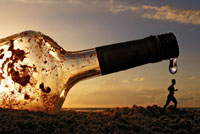US Dry Law Revitalized Nation and Organized Crime
Ninety years ago, on January 16, 1920, the Eighteenth Amendment came into effect in the US, prohibiting or limiting sale, manufacture, and transportation of alcohol for consumption.

It was not a new initiative, since the first restrictions for manufacturing and sales of alcohol in the US took place as early as in the middle of the 19th century. Prohibition was introduced in different states from time to time, but each time it was quickly cancelled, and even recognized as non-constitutional in some of them. In the late 1890s, American politicians were actively employing slogans calling to fight consumption and manufacturing of alcohol. The nation supported them and even created various anti-alcohol societies.
In 1905, prohibition law was in effect in Kansas, Main, Nebraska, and North Dakota. By 1912, the law was enforced in nine states and additional 26 states four years later. When the US entered World War I, the government tried to keep grain reserves intact, which allowed supporters of prohibition enacting a national ban on alcohol manufacturing. Pharmacists and chemists supported struggle against alcohol. They were interested in new markets, and pharmacists were actively promoting beverages containing Columbian coca, since cocaine was not considered an illegal drug at the time.
Prohibition initiative yielded good results, and in 1917 the US Congress proposed the Eighteenth Amendment introducing the “dry law” in the entire US. In fall of 1917, the US stopped production of whisky, and in May of 1919 the production of beer was also stopped.
The Volstead Act, governing the forced enforcement of the Amendment, passed through Congress over President Woodrow Wilson 's veto in October 1919. The document was enacted on January 16, 1920.
According to the American statistics of that period, the results of the struggle for the nation’s health were overwhelming. Within the first few months of prohibition, 236 hard liquor plants and 1,092 breweries were shut down, accompanied by 177,790 bars and saloons.
G. Goslar provided interesting facts in his book “Contemporary America” published in 1925. He wrote that within three years of prohibition, the nation’s health greatly improved. The number of those arrested decreased 3.5 times, including those arrested for vagabondism, while working conditions and unemployment rate remained the same.
In Philadelphia, 1,100 prison cells were empty nine months after the enactment of prohibition, and the number of prisoners dropped from 2,000 to 474, more than four-fold. As of April 1, 1920, there were 600 out of 25,000 prisoners left in a Chicago prison, a 70% decrease. People drank more milk and were wealthier, family morale strengthened and savings increased.
It seemed that the law was workingandthenation’s health was improving. Yet, America was not ready to a rampant growth of organized crime caused by bootlegging.
By the mid 1920s, gangsters virtually wiped out the effect of the Eighteenth Amendment. Special fleets were created for bringing alcohol into the country, and trains and automobiles were actively utilized for bootlegging purposes. This caused growth in corruption at customs and in police departments. By the late 1920s, bootlegging brought mafia over $2 billion in profits.
The US government was not able to shut down the illegal import of alcohol. 2.5 thousands of special agents were appointed to control the implementation of the dry law, but their actions proved ineffective. A high-ranking official from the Department of Finance once said that only 5% of bootlegged alcohol was seized by the government. The US lost the fight against alcohol .
According to official information, the country spent over $12 million dollars on prohibition, and in December of 1933, the ratification of the Twenty-first Amendment repealed the Eighteenth Amendment.
Regardless of the position of local authorities, certain states restricted alcohol sales on a smaller scale. For instance, Oklahoma and Kansas were still “dry” in 1948, and the state of Mississippi was the last one to abolish the restrictions in 1966.
Russia decided to conduct a similar experience 65 years after prohibition came into force in the US. On May 16, 1985, the USSR government created a decree that was to “enhance struggle against alcoholism,” that received an unofficial name “semi-dry law.”
Propaganda of sobriety, increase in alcohol prices and barbarian destruction of vineries both in the USSR and the US were followed by growth of illegal alcohol production. Actual decrease in consumption of alcohol was less significant than expected due to the development of moonshine production and illegal production of alcoholic beverages at state-owned factories. Growth in moonshine production caused deficit of sugar and cheap candy used as raw materials.
Soon, the USSR government made a decision to abolish prohibitive measures, prompted by mass anti-prohibition campaigns and the economic crisis of 1987.
Decades later, the term “dry law” brings to memory the 1920s in the US or Gorbachev’s campaign in the 1980s in the USSR. They were two large nations who tried to improve national health by forcing sobriety.
Yet, “dry laws” are not a rare concept. Many countries tried to enforce prohibition and some countries still have it in effect, including Turkey, Egypt, and Arab Emirates. In these countries, however, prohibition is more than a state law.
Maxim Kondratyev
Pravda.Ru
Subscribe to Pravda.Ru Telegram channel, Facebook, RSS!





